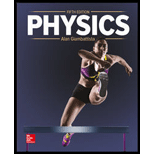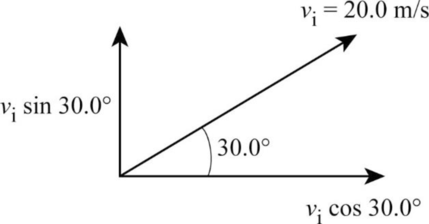
Concept explainers
(a)
The time taken for the stone to reach the base of the gorge.
(a)
Answer to Problem 83P
The time taken for the stone to reach the base of the gorge is
Explanation of Solution
Write the equation for the time taken for the stone to reach the base of the gorge.
Here,
Conclusion:
Substitute
Thus, the time taken for the stone to reach the base of the gorge is
(b)
The time taken for the stone to reach the ground if it is thrown straight down.
(b)
Answer to Problem 83P
The time taken for the stone to reach the ground if it is thrown straight down is
Explanation of Solution
Write the equation for the vertical distance.
Here,
Rearrange equation (II),
Conclusion:
Substitute
The value of t can be found by solving the above quadratic equation.
Substitute
As the time must be positive, the time taken for the stone to reach the ground if it is thrown straight down is
(c)
The distance below the bridge the stone will hit the ground.
(c)
Answer to Problem 83P
The distance below the bridge the stone will hit the ground is
Explanation of Solution
Figure 1 shows the components of velocities.

Figure 1
Write the equation for the vertical distance.
Here,
Solve equation (III) ,
Write the equation for the horizontal distance.
Conclusion:
Substitute
Find the value of
Substitute
As the time must be positive, the time taken is
Substitute
Therefore, the distance below the bridge the stone will hit the ground is
Want to see more full solutions like this?
Chapter 3 Solutions
Physics
- You throw a ball straight up. The ball leaves your hand at a height of 2.00 m above the ground with a speedof 20.0 m/s (~45 mph). Ignore air resistance and use g = 10.0 m/s2. You can use a spreadsheet but show asample calculation for the velocity and the position at t = 1.5 s.arrow_forwardChapter 06, Problem 85 Your answer is partially correct. Try again. A water slide is constructed so that swimmers, starting from rest at the top of the slide, leave the end of the slide traveling horizontally. As the drawing shows, one person hits the water 5.00 m from the end of the slide in a time of 0.454 s after leaving the slide. Ignore friction and air resistance, find the height H in the drawing. Water slide H. 5.00 m Number Units 8.404arrow_forwardA theme park is planning out a new free-fall ride. The drop is almost perfectly frictionless, with a distance of 190 meters. Assuming that the initial velocity was zero, what would be the speed at the bottom of the drop? 1 53 m/s 2 61 m/s 3 67 m/s 4 72 m/sarrow_forward
- You are throwing an egg straight down from the roof of a building at a speed of 13.6 m/s. The building has a height of 37.9 m. Ignoring air resistance, at what speed does the egg hits the ground?arrow_forwardA skier with a mass of 63.0 kg starts from rest and skis down an icy slope that has a length of 53.0 m at an angle of 32 degrees with respect to the horizontal. At the bottom of the slope, the path levels out and becomes horizontal, the snow becomes less icy, and the skier begins to slow down, coming to rest in a distance of 122m along the horizontal path. What is the speed of the skier at the bottom of the slope? What is the coefficient of kinetic friction between the skier and the horizontal surface?arrow_forwardA small block slides down a frictionless track whose shape is described by y = (x^2) /d for x<0 and by y = -(x^2)/d for x>0. The value of d = 4.93m, and x and y are measured in meters as usual. You start the block on the track at rest, somewhere to the left of x = 0. You then release the block from rest and let it slide down. What is the maximum value of x (that is, what is the closest to the origin) from which you can release the block from rest and have it leave the track at x = 0 and go into freefall? -1.75 m -3.38 m -3.59 m -2.47 marrow_forward
- A physics book slides off a horizontal tabletop with a speedof 1.10 m/s. It strikes the floor in 0.480 s. Ignore air resistance. Find the height of the tabletop above the floorarrow_forwardA slanted roof rises at 35° above the horizontal, and the straight-line distance from the top of the roof to the bottom edge is 4.5 m. The roof is covered with ice, so it offers no friction to objects sliding on it. A piece of ice at the top suddenly breaks loose and begins to slide down from rest.(a) How long will it take for the ice to reach the bottom edge of the roof?(b) How fast will the ice be traveling just as it reaches the bottom edge?arrow_forwardThe Zero Gravity Research Facility at the NASA Glenn Research Center includes a 145 m drop tower.This is an evacuated vertical tower through which, among other possibilities, a 1-m-diameter sphere containing an experimental package can be dropped. (a) How long is the sphere in free fall? (b) What is its speed just as it reaches a catching device at the bottom of the tower? (c) When caught, the sphere experiences an average deceleration of 25g as its speed is reduced to zero.Through what distance does it travel during the deceleration?arrow_forward
- A pebble rolls off the roof of Science Hall and falls vertically. Just before it reaches the ground, the pebble's speed is 17 m/s. Neglect air resistance and determine the height of Science Hall.arrow_forwardBart Jumps Springfield Gorge on his skateboard. Springfield Gorge us 50m wide, and Bart has constructed a 1.0 m Hugh ramp inclined at 30° to the horizontal. Air resistance is neglected. Homer had calculated that he can jump the gorge if the ramp is inclined to 45°, and he attains a speed of 20m/s. Will Homer make it? If not, how far short of the other side is he when he drops below the level of the ground?arrow_forwardA parachutist’s fall to Earth is determined by two opposing forces. A gravitational force of 539 N acts on the parachutist. After 2 s, she opens her parachute and experiences an air resistance of 615 N. At what speed is the parachutist falling after 10 s?arrow_forward
 Principles of Physics: A Calculus-Based TextPhysicsISBN:9781133104261Author:Raymond A. Serway, John W. JewettPublisher:Cengage Learning
Principles of Physics: A Calculus-Based TextPhysicsISBN:9781133104261Author:Raymond A. Serway, John W. JewettPublisher:Cengage Learning
